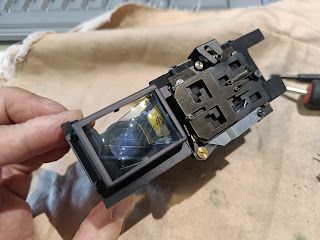I came across this Kowa Six II (the original Six did not have interchangeable film back) while I was traveling in Japan. It was in a used camera store at a very good price and I could not resist. Even though I heard a lot of stories of reliability issues with this camera, I went ahead and bought it. We are now shooting these cameras only occasionally and not shooting hundred of rolls of films a week like the pros were doing in the past. In the store I was able to run through a test roll of 120 film through the camera. The lens was clean, all shutter speeds fired and seem to be correct. It came with one film back. I wish there is another as they are hard to come by and defeat the object of having a camera with interchangeable film back.
 |
| Kowa Six II |
 |
| Note MLU, safety latch for film back and film door |
 |
| Double exposure switch & film back latch |
 |
| Film back removed from camera body |
Once back home I gave it a clean up and went online to learn more about this camera. I then replaced the mirror foam, took the panel off the mirror mechanism side. There are a lot of foam the had disintegrated. Replacing them was not difficult, but messy. While the panel was off, I also lubricated all moving parts with a very small amount of oil.
 |
winding side panel removed showing the
disintegrated foam light seals |
I then went out to London and shot some street portraits. The photos came out fine and I can confirm the camera worked as intended and film spacing was good. Here are a few images all shot with the 85mm F2.8 lens.
That is not the end of the story. A few months after, I saw a Facebook market place posting for a Kowa Super 66 with two film backs, 85mm F2.8, 55mm F3.5 and 90° prism finder and side grip. The asking price was too high, but over time, the cost was reduced and eventually it was worth me buying it. I went to test the camera and it all was working so I bought the complete outfit.
 |
| Kowa Super 66 |
 |
| No MLU, no safety latch for film back or film door |
 |
| Double exposure switch, but not film back latch |
These are the main differences I can see. Anything not mentions means they are the same.
Six II body have a safety latch to prevent accidental release of film back.
The Six II film back have a safety lock to prevent the film door opening.
The Six II body have mirror lock up, Supper 66 does not.
The Six II body has an additional shutter release cable attachment point below the shutter button. It allows a shutter release cable to screw in from under the camera.
Anyway, I cleaned up the Super 66 and went out to Greenwich in London on a sunny day and shot a roll of expired Konica Centuria Color 100 film. Here are a few photos. The first three photos were shot with 55mm lens, while the last photo was shot with 85mm lens. I like the photos. I will need to replace the mirror foams and light seals in the near future. I didn't want to spend time doing all this without confirming the camera is working.
In the end, these two cameras are very similar. In term of features, the Kowa Six II have MLU and safety latch for the film back release and film door. It is very easy to open the film door by accident with the Super 66. Personally, I would prefer to have an original Kowa Six. They are cheaper, smaller and lighter. Lack of double exposure and mirror lock up not going bother me. I have many cameras that have both features, and have never used them.
A final comment I want to make is people keep saying it is unreliable. These cameras are fully mechanical and are over 50 year old. They will need some some work on them. To expect a 50 year old camera to work without any work is expecting too much. If you buy one of these camera, I would at least recommend all the light seals be replaced. Check the shutter is working at all speeds. If you can, take the sides off and lubricate all the moving parts with small amount of oil.




























































